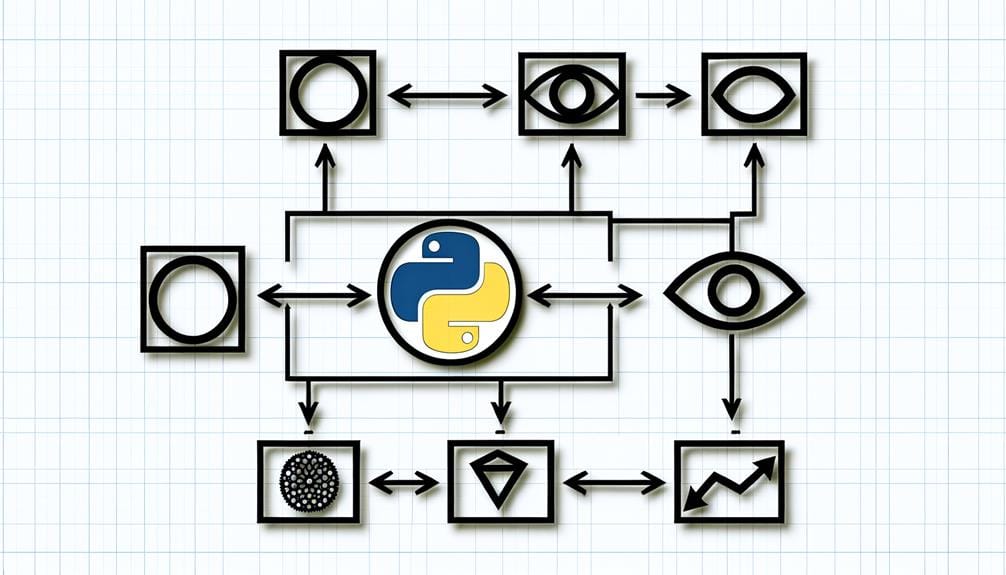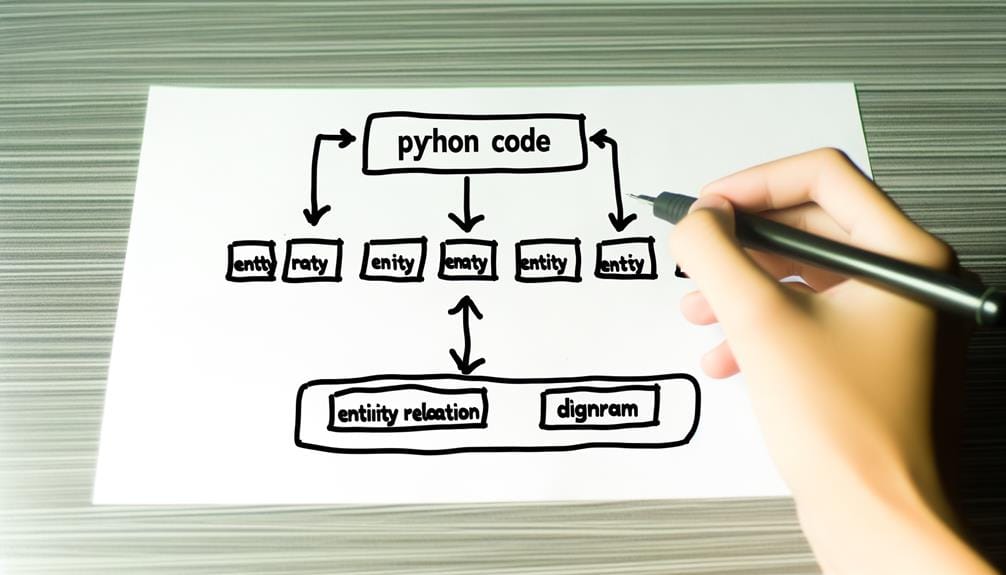To create an entity relation diagram for SEO using Python, we first extract information using Python libraries such as SpaCy and NetworkX. We utilize SpaCy for natural language processing and entity recognition, and NetworkX to visualize entity relations. This data is then structured into diagrams that shed light on the complex relationships within. These insights inform our SEO optimization strategies. Analyzing the diagrams, we unearth hidden patterns, tailoring our approach to SEO. As you press forward, you'll gain a deeper understanding of this potent concept and learn how to tap into its potential for your SEO success.
Key Takeaways
- Use Python libraries like SpaCy for entity extraction and understanding the context of entities in the content for SEO.
- Implement Python's NetworkX library to visualize the extracted entities and their relationships in an Entity Relation Diagram.
- Analyze the Entity Relation Diagram to understand complex relationships and correlations, guiding SEO strategy development.
- Incorporate NLP techniques using Python to accurately identify and categorize entities, enhancing the comprehensibility of the diagram.
- Use the diagram insights to optimize web content, aligning with search engine algorithms, and improving website visibility and ranking.
Understanding Information Extraction
To comprehend the importance of Information Extraction in SEO, we must first delve into its role in creating a Knowledge Graph and analyzing text using Python libraries such as SpaCy. This process allows us to visualize entity relations, a crucial factor influencing SEO impact. By identifying and classifying entities within a text, we create a structured representation of data, optimizing content for better search engine recognition. In SEO, this equates to improved website visibility and ranking. The extracted entities contribute to content optimization, making it more informative and relevant to user queries. In this context, the entity relation visualization serves as a roadmap, guiding us in creating content that aligns with search engine algorithms and user expectations.
Role of Python in SEO

Harnessing the power of Python in SEO, we can streamline the creation of entity relation diagrams and knowledge graphs, essential tools for understanding and optimizing digital content. Python integration gives us a significant advantage in SEO automation, simplifying complex tasks and making data analysis more efficient.
Here's a brief overview of the role Python plays in SEO:
| Python in SEO | Benefit | Example |
|---|---|---|
| Automation | Simplifies tasks | Automating keyword research |
| Data Analysis | Enhances understanding | Mining SEO data |
| Integration | Streamlines processes | Integrating with SEO tools |
| Speed | Saves time | Rapid data processing |
| Scalability | Handles large data sets | Analyzing big SEO data |
Introduction to Entity Relation Diagrams

Delving into the realm of Entity Relation Diagrams, we find an indispensable tool for visualizing and understanding the complex relationships between different entities in our SEO data. These diagrams, powered by entity visualization techniques, allow us to map out and analyze the intricate web of connections between entities. They present a clear and concise picture of how various elements interact within the larger SEO context. This enables us to conduct a comprehensive entity relationship analysis, which is pivotal in crafting tailored SEO strategies. As we dissect these diagrams, we uncover hidden patterns and correlations, providing us with actionable insights. In essence, Entity Relation Diagrams are an instrumental component in our SEO toolkit, paving the way for effective data-driven decisions.
Using SpaCy for Entity Extraction

In our journey to create an effective SEO strategy, we'll employ the power of SpaCy, a Python library renowned for its proficiency in extracting and analyzing entities from text. By implementing SpaCy, we aim to improve our text analysis and entity recognition, which are crucial for our SEO optimization efforts.
- Firstly, we use SpaCy's NLP capabilities to extract entities from a block of text. This forms the basis of our entity recognition strategy.
- Secondly, we analyze these entities, understanding their context and significance in the text.
- Lastly, we visualize these entities, creating a clear representation of their relationships and hierarchy.
This process not only helps in entity visualization but also plays a significant role in optimizing our SEO strategy, by providing clear, concise, and precise information.
Creating a Knowledge Graph With Python

Let's now shift our focus to the process of creating a knowledge graph with Python, a critical step in structuring and visualizing the extracted entities for an optimized SEO strategy. To build a knowledge graph, we'll utilize Python's robust libraries for data analysis and visualization. The knowledge graph visualization techniques we'll employ involve constructing a semantic network of entities, highlighting their interrelations. This network aids in semantic analysis for SEO optimization by revealing connections and gaps in content. We'll also use Python's advanced tools for semantic analysis, enabling us to better understand the meaning and context of our extracted entities. This process not only clarifies our SEO strategy but also enhances the comprehensibility and relevance of our web content.
Analyzing Text With Natural Language Processing

Moving forward with our discussion, we need to delve into the process of analyzing text with Natural Language Processing (NLP), a pivotal technique that aids in understanding and extracting meaning from our content for effective SEO implementation.
- Text Analysis Techniques: We use these to break down and interpret our content. They allow us to understand the sentiment, extract key phrases and identify topics, thus aiding in semantic entity extraction.
- Semantic Entity Extraction: With NLP, we're able to identify and categorize key parts of our content into entities that carry semantic meaning.
- NLP in Python: We utilize libraries like NLTK and SpaCy to implement NLP and conduct text analysis, creating a structured understanding from unstructured data, which is vital in SEO.
Data Science in SEO Strategies

Harnessing the power of data science, we can significantly improve our SEO strategies by understanding search engine algorithms, conducting A/B tests, and enhancing content quality. SEO data analysis allows us to dissect the complexities of algorithms, providing insights into how search engines rank content. This knowledge guides us in optimizing our websites for higher visibility and traffic. Machine learning applications further refine our strategies by predicting user behavior and preferences. We're able to tailor content that not only ranks higher but also resonates with our target audience. A/B tests, backed by data science, allow us to compare different SEO approaches, making informed decisions on what works best. In essence, data science offers a methodological approach to SEO, enabling us to deliver high-quality, relevant content consistently.
Importance of Web Design in SEO

While data science optimizes our content from an analytical perspective, the role of web design in shaping our SEO strategies cannot be understated. Web design impacts SEO and user experience in significant ways:
- User-Friendly Design: A user-friendly web design enhances user experience, leading to increased engagement and lower bounce rates. This directly affects the site's SEO performance.
- Mobile Optimization: Mobile-friendly designs are favored by search engines, significantly affecting rankings.
- Site Speed: Web design also influences site speed. Fast-loading sites are ranked higher by search engines, boosting SEO.
In essence, web design plays a critical role in SEO. A well-designed site not only appeals to users but also to search engines, contributing to the overall success of our SEO efforts. Remember, design impact on rankings is a reality we can't overlook.
Implementing Python for Knowledge Graphs

So, how exactly do we implement Python in the creation and processing of Knowledge Graphs for SEO? We begin by utilizing Python libraries like SpaCy and NetworkX for natural language processing and graph theory, respectively. These tools help us extract entities from unstructured data, paving the way for semantic hierarchy creation. Next, we apply entity visualization techniques, transforming the extracted entities into a visual graph. This graph, which we call a Knowledge Graph, connects the entities based on their relationships, allowing us to understand their interactions. Analyzing this graph provides insights into the structure of our content and reveals gaps that need addressing. In essence, Python plays an instrumental role in transforming raw data into actionable SEO strategies.
Entity Relationships and SEO

In our quest to optimize SEO strategies, we must delve into the intricate world of entity relationships and their profound impact on search engine performance. This process, called entity relationships analysis, forms the backbone of our SEO impact assessment.
- By mapping out entity relationships, we can understand the semantic hierarchies within our content. This exploration provides valuable insight into how search engines interpret and rank our pages.
- Through this analysis, we can identify gaps in our content coverage and strategically fill them to boost our SEO performance.
- Furthermore, understanding these relationships allows us to predict how changes in one entity might affect others, providing a proactive approach to SEO management.
In essence, understanding entity relationships is crucial for a holistic and effective SEO strategy.
Improving SEO Performance With Python

Harnessing the power of Python, we can significantly enhance our SEO performance by creating entity relation diagrams and processing knowledge graphs. Python tools for SEO analysis, such as SpaCy and Numpy, provide us with a powerful method for enhancing SEO content with entities.
| Python Tools | SEO Enhancement |
|---|---|
| SpaCy | Entity Extraction |
| Numpy | Data Manipulation |
| Pandas | Data Analysis |
| NetworkX | Graph Creation |
| PyTorch | Machine Learning |
These tools allow us to extract key information from text, manipulate and analyze data, create complex graphs, and apply machine learning algorithms. Leveraging these capabilities, we can understand content deeply, identify gaps, and create more effective SEO strategies. Python's flexibility and power make it an invaluable resource in our SEO toolkit.
Frequently Asked Questions
What Are Some Specific Examples of Python Scripts Used for SEO Tasks?
We've used Python automation for several SEO tasks. For instance, we've developed scripts for keyword research, tracking search engine rankings, and analyzing backlink profiles. Another great example is our bespoke Python script for SEO analytics, which helps us dissect traffic data and understand user behavior. This data-driven approach allows us to refine our SEO strategies and make informed decisions. Python has truly revolutionized how we handle SEO tasks.
How Does an Entity Relation Diagram Improve Search Engine Rankings?
We've found that an Entity Relation Diagram aids in improving search engine rankings by providing a clear structure of website content. This diagram implementation allows search engines to understand the relationships between different entities on a site, thus enhancing its relevance to particular search queries. Moreover, it helps us optimize key ranking metrics, such as site architecture and internal linking, making the site more crawlable and user-friendly.
Can Natural Language Processing Be Used for Other Languages Besides English in Seo?
Absolutely, we can use Natural Language Processing (NLP) for languages besides English in SEO. Multilingual NLP allows us to analyze and understand content in various languages. This is crucial for SEO Localization, as it aids in optimizing content for different regions and languages. By employing NLP tools that support multiple languages, we're able to provide more targeted, relevant content to a diverse audience, enhancing our global SEO strategy.
What Are the Key Differences Between Information Extraction and Knowledge Graph Creation?
We've found that extraction techniques focus on pulling specific data from text, while knowledge graph creation is about mapping relationships between extracted entities. While both are crucial for SEO, they serve different purposes. Extraction is about identifying, knowledge graphing is about connecting. It's also worth noting the limitations of knowledge graphs. They rely heavily on the quality of extracted data. If the extraction's flawed, the graph won't accurately represent the relationships.
Is Web Design an Essential Factor in All Types of SEO Strategies?
Absolutely! We view web design as the welcoming porch of a house. If it's inviting, people step in, if not, they walk away. Design aesthetics influence user experience significantly. A cluttered, unattractive design can deter users, affecting SEO negatively. Conversely, an aesthetically pleasing, user-friendly design can boost engagement, keeping users on the site longer and improving SEO. So, in all types of SEO strategies, web design is indeed essential.



